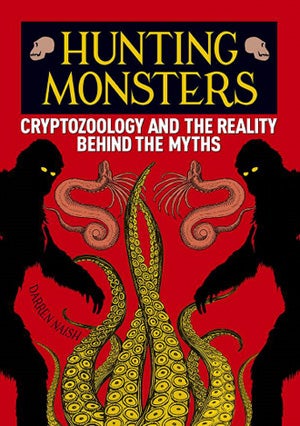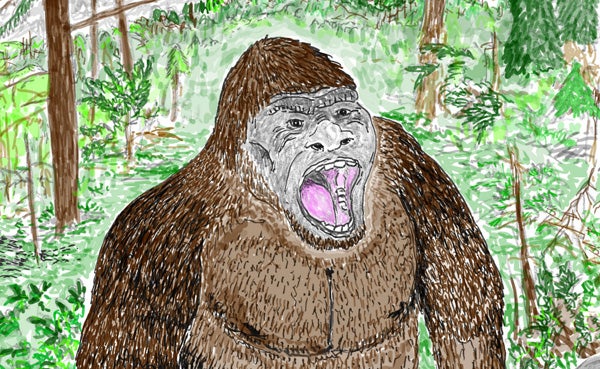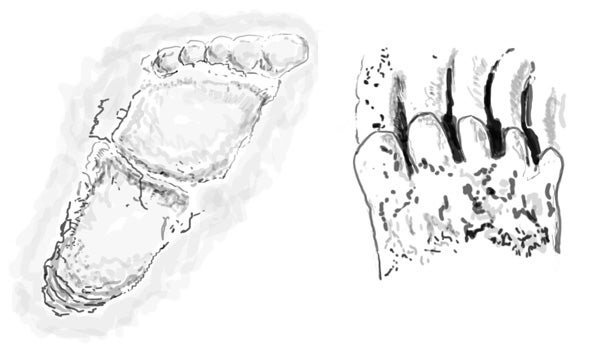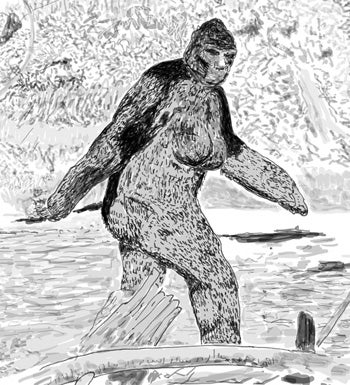This article was published in Scientific American’s former blog network and reflects the views of the author, not necessarily those of Scientific American
You will, I’m sure, have heard of the unconfirmed North American primate vernacularly termed Bigfoot or Sasquatch.

The cover of Naish (2016): the black figure with glowing eyes is especially relevant to this article.
I have a long-term, unshakeable interest in Bigfoot, and I’ve thought about the subject quite a lot, at least some of these thoughts having appeared here at Tet Zoo over the years. I do not think that the data we have at the moment – this includes tracks, hairs, vocalisations, photos, and the innumerable eyewitness accounts – provides support for the notion that Bigfoot is real, and have come to the conclusion that it is a sociocultural phenomenon: that people are seeing all manner of different things, combining it with ideas, memes and preconceptions they hold in their minds, and interpreting them as encounters with a monstrous, human-like biped. This contention is explored further in my recently-published book, Hunting Monsters (Naish 2016) (and, to prove that I have history, there’s also Naish (2012)).
On supporting science journalism
If you're enjoying this article, consider supporting our award-winning journalism by subscribing. By purchasing a subscription you are helping to ensure the future of impactful stories about the discoveries and ideas shaping our world today.
And let me say, by the way, that I would love to be wrong… I still do hope that Bigfoot is real; that the version of the creature endorsed by Krantz (1999), Bindernagel (1998) and Meldrum (2006) is accurate and valid. But, alas.
Regular readers of Tet Zoo – and of certain of the things I’ve published (Conway et al. 2013, Naish 2014) – will be familiar with the idea that cryptozoology overlaps extensively with speculative zoology. Bigfoot might not be a genuine undiscovered primate species (so far as we can tell, right now)… but what if it was? In this article, and perhaps in one or two others that might appear in future, I’d like to play a game and ponder things pertaining to the Bigfoot evidence, such as it is. It is, after all, great fun to wonder what the existence of Bigfoot would mean for field biology and ecology in North America, for conservation and wildlife management, for our understanding of primate evolution and diversity, and for the relationship we have with the rest of the natural world. I’m not about to write about all of those hypotheticals right now, but, yes, they’re entertaining things to think about. In fact, I’d love to see some speculative fiction written along those lines… oh, to be fair, there is some stuff out there like that already: I’m only familiar with Lee Murphy’s books.
Incidentally, an interesting thing I’ve learnt about Bigfoot while writing this article (and others) is that there’s scarcely any Bigfoot imagery online which is marked for re-use: everything is protected by copyright and unavailable for free use by others. Make of that what you will. In the interests of making the world a better place, the pictures I created for this article are all released for use via a CC license.
Biologically consistent, homogenous vocalisations would be documented across North America. Bigfoots purportedly make noises, and a standard part of modern Bigfoot lore is that people might be able to ‘call in’ or even communicate with Bigfoots by making wails, screams, roars or howls, or by hitting trees or rocks to make far-carrying percussive whacks, these sounds resembling the noises that are attributed to the creature. What’s notable is that these vocalisations are phenomenally diverse: the ‘Ohio howls’, ‘Samurai chatter’, the whoops, whistles, growls and howls attributed to this animal well exceed what we’d expect for a single animal species that communicates over long distances, and there’s nothing approaching homogeneity of the sort present across known primate species.

Bigfoot apparently does a lot of vocalising. This image is inspired by a particular scene you might recognise from the Animal Planet series Finding Bigfoot. Credit: Darren Naish
Indeed, some of the most incredible of these sounds – if you’ve never heard the ‘Sierra sounds’ or ‘Samurai chatter’ recorded by Ron Morehead, well, you’re in for a treat – sound nothing at all like the others that have been reported and recorded, and have only been heard exclusively in one small area. Even allowing for the possibility of regional and local dialects, of ontogenetic, annual or seasonal variation, or of this diversity being linked to a diversity of functional roles (close communication vs long-distance communication, mating calls vs parental vocalisations and so on), the noises and calls are absolutely all over the place and not in the least bit homogenous from one region to the next, as they should be if we’re dealing with an unknown primate species.
The conclusion must be that the noises have diverse origins, by which I mean that they are mostly sounds made by known animal species, including cattle, coyotes (and their hybrids) and humans. And, yes, I think that many of the more incredible Bigfoot sounds – ‘Sumarai chatter’ and other speech-like utterances among them – were generated by people.
Bigfoot tracks would be easy to find by people who know what they’re doing. If Bigfoot is super-rare (as some, though not all, proponents argue that it is), it might follow that its tracks would be rarely encountered and hard to find. That seems reasonable. But the fact is that people who actually track known animal species in a professional or technical capacity are near-universally of the opinion that Bigfoot is not a real animal: (1) they, and their colleagues, don’t find evidence for it themselves, and (2) the evidence they have seen is fraudulent or unconvincing. Note that even some of Bigfoot’s most noted investigators – I’m thinking of the late René Dahinden – never found tracks themselves.
For a large, ground-dwelling mammal that leaves conspicuous tracks and supposedly occurs continent-wide, Bigfoot is unrealistically cryptic; if it were real, biologists would be at least occasionally finding and reporting its tracks, at at least the same frequency as they do the tracks of such mammals as wolverines, jaguars, pumas and ocelots, all of which are extremely rare and even of controversial status within certain parts of the USA. The fact that Bigfoot tracks are not found by people trained and with the expertise to do so is a red flag. I’m sorry if this sounds elitist; even if it does, that doesn’t stop it from being true.
Bigfoot tracks would be more ‘biological’. A little-discussed aspect of the many Bigfoot tracks on record is that they’re decidedly… clean. Yes, there are some famous examples that feature what look like scars and dents, plus there are the infamous Bossburg ‘cripple foot’ tracks… all of which are of doubtful origin and are associated with individuals widely thought – even by proponents – to be hoaxers. But even leaving those aside, the remaining tracks are weird.

A famous sequence of tracks from Bossburg, Washington state, were supposedly made by a Bigfoot with a malformed left foot. The tracks were generally found alongside a road and could be linked to a source considered unreliable even by Bigfoot proponents. Credit: Darren Naish
They typically look so neat, so clean. The toes are all too frequently neatly placed together in close contact, and the sole and ball of the foot are smooth and mostly featureless. What I’m getting at is that these don’t look like real animal tracks, as they should if Bigfoot were real. In a primate with a human-like foot – especially an enormously big, heavy, bipedal one – the toes should consistently splay apart, as they do in people who go their lives without shoes. And, based on the appearance of wild-living primate feet (humans included), shouldn’t Bigfoot have soles that are gnarly, rough, cracked, wrinkled and fissured? As it is, the soles and balls of Bigfoot tracks look like those of domestic humans who have never walked barefoot outdoors, let alone an animal that lives in forests and mountains, endures freezing outdoor conditions, and walks routinely on rough terrain.

All too many Bigfoot prints are unrealistically 'tidy', with closely packed (not spreading), tidily parallel toes and clean, featureless soles. They look to be modelled on the feet of domestic, shoe-wearing humans, not on wild-living primates. At left, a depiction of one of the Bluff Creek tracks from 1967. At right, depiction of a cast and its associated marks, discovered at Walla Walla, Washington. Credit: Darren Naish
I’m not commenting here on dermal ridges or the alleged mid-tarsal break: neither stand up as evidence supporting the reality of Bigfoot. I discussed both in my recent book (Naish 2016).
There would be Bigfoot DNA all over the place. Anyone who knows anything about Bigfoot knows that there have been several recent claims concerning the discovery of Bigfoot DNA. So far, none have panned out. In the best known study – the one led by Melba Ketchum, published in a paywalled journal created solely to carry the study itself – Bigfoot was reported to be some sort of hybrid between Homo sapiens and an unidentified second species. The results were widely discussed and derided by qualified working geneticists who showed how the genetic results seemed to mix human with that of other mammals, dogs and bears among them. None of the sequences could be taken to support the hybridisation hypothesis integral to the conclusions. And some geneticists are on record as describing the manuscript as “utter nonsense”.
A popular idea in some sectors of the Bigfoot community is that the value and quality of the Ketchum study was played down by cowardly scientists and journal editors who didn’t have the balls or integrity to see it get fair treatment. Indeed Ketchum herself wrote of witnessing gross bias, and even referred to the “Galileo Effect”. In fact, the Ketchum study – which was submitted to several top-end journals prior to eventual publication – was treated thoroughly and ethically, and found wanting for the reasons mentioned above. An excellent and thorough analysis of the whole episode can be found here.

Striding female of a giant, wild-living hominid that still defies recognised scientific detection, or fat guy in a suit? This image depicts the famous frame 352 of the Patterson-Gimlin film. Credit: Darren Naish
Anyway, my primary point here is that DNA that can’t be explained other than by the existence of an unknown distinct primate has not been documented, whereas it would be present all over the place if Bigfoot were real, even if it were an unusual sub-population of Homo sapiens. And those of you thinking that this is a dumb thing to say in view of the absence or rarity of alleged Bigfoot remains should note that the collection and examination of eDNA – that is, residual DNA collected from the environment (yes, from water, ice and sediment) – is now widespread and commonplace.
The main takehome from what I’ve said here – and I’m repeating what many other scientists have said before me – is that an awful lot of good evidence would have been documented by now if Bigfoot were real. As interesting and intriguing as all those eyewitness reports are, we are simply not seeing the evidence we should, nor is the evidence we have at all convincing. So... why is that?
For previous Tet Zoo articles relevant to the subject of Bigfoot, see...
Is Cryptozoology Good or Bad for Science? (review of Loxton & Prothero 2013)
My New Book Hunting Monsters: Cryptozoology and the Reality Behind the Myths
Refs - -
Bindernagel, J.A. 1998. North America’s Great Ape: the Sasquatch. Beachcomber Books, Courtenay, B.C.
Conway, J., Kosemen, C. M. & Naish, D. 2013. Cryptozoologicon Volume I. Irregular Books.
Krantz, G. S. 1999. Bigfoot Sasquatch Evidence. Hancock House, Surrey, B.C. & Blaine, WA.
Meldrum, D. J. 2006. Sasquatch: Legend Meets Science. Tom Doherty Associates, New York.
Naish, D. 2012. Should we give up looking for Bigfoot? BBC Focus March 2012, 27.
Naish, D. 2014. Speculative zoology. Fortean Times 316, 52-53.